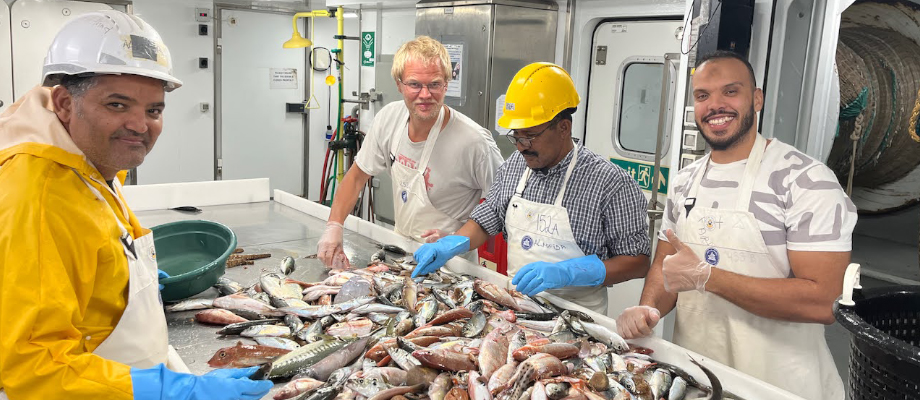Improving the understanding of pelagic fish in northwest African waters

18 December 2023, Casablanca, Morocco – The research vessel (R/V) Dr. Fridtjof Nansen has completed 84 days at sea, carrying out a transboundary pelagic survey off the coast of northwest Africa. The survey resulted in information and data on pelagic fish species, like sardines, that are of huge importance to the food and livelihood of people in the region.
“Pelagic fish is a staple food and a vital source of protein intake in northwest African countries, but the influence of fishing and environmental factors needs to be better understood so that we can ensure that the stocks and ecosystems are healthy,” said Ndague Diogoul, a fisheries scientist from Senegal and one of the local co-cruise leaders of the survey.
The transboundary nature of the pelagic fish emphasizes the necessity for countries to come together for their assessment to ensure the sustainable management and preservation of these fish stocks across the subregion.
The survey that started in Dakar, Senegal on 21 September and ended on 17 December in Casablanca, Morocco, was divided into three separate legs. In total, 87 scientists and technicians from Morocco, Mauritania, Senegal, Sierra Leone, Liberia, Cabo Verde, Côte d'Ivoire, The Gambia and the Institute of Marine Research (IMR) in Norway participated, joined by the crew members that operate the vessel.
“Collaboration is key when it comes to understanding transboundary species that move across borders, and the R/V Dr. Fridtjof Nansen is a unique platform that brings people together” said Arnault Le Bris, a senior researcher at IMR, who was one of the cruise leaders of the first part of the survey that covered The Gambia and Senegal, followed by the continental shelf off Mauritania until Cap Blanc.
The main goal of the survey was to collect information on the abundance, biomass, species composition, and distribution of pelagic fish species. Pelagic fish, like sardines (Sardina pilchardus), are widely distributed from Mauritania in the south, in the Mediterranean, and in the Atlantic Ocean all the way north into the North Sea.
“The strong upwelling off northwest Africa makes it a perfect habitat for the sardine, and more than 500 000 tonnes are caught in this region every year,” said Erik Olsen, Head of Research at IMR, who led the survey from Cap Blanc to Cap Ghir. However, identifying these species during the surveys can be tricky, Erik explained. “When we see registrations of fish schools on the echosounder, we quickly put out the trawl, and thanks to the experience of the vessel crew we are able to hit the school and get a sample of the fish that was seen.” Once on deck, the trawl is weighed before the catch is sorted and sampled for further analysis.
As the vessel was approaching Casablanca, it was joined by the Moroccan research vessel Al Hassan Al Marrakchi. For two acoustic transects it sailed behind the R/V Dr. Fridtjof Nansen with the purpose of making a first comparison of the acoustic recordings and trawl catches between the two vessels.
“This was a rare opportunity to calibrate the vessels to get more accurate and comprehensive biomass estimates” said Maik Tiedeman, a researcher from IMR, who was leading this part of the leg alongside co-cruise leader Zakaria Zouine from Morocco, who was pleased to experience the collaborative effort. “Exchanging expertise strengthens our research efforts and will contribute to our goal of improving fisheries management of shared marine resources.”
Beyond the core survey objectives, the time aboard the vessel serves as a platform for the participating scientists to share their work and refine their skills. From scientific talks on topics ranging from mussels as the sentinels of ocean pollution, fishery assessment methods, and the atmospheric and oceanographic features of the Canary Current Large Marine Ecosystem (CCLME), every stage of the survey becomes an opportunity for professional growth.
“I truly enjoyed the experience I had aboard the vessel,” said Salaheddine Sbiba, a Ph.D. student from Morocco and one of the local survey participants that delivered a presentation on his work on the stock structure and migration of Scomber colias (Atlantic chub mackarel). “Spending time with the crew and fellow members of the scientific community taught me a lot and left me feeling inspired and excited about the potential impact we can have on the sustainable management of these important resources,” Salaheddine added.
During the final third and final part of the survey, the vessel covered areas from Cap Ghir to Tanger, led by the cruise leader Kathrine Michalsen, a senior researcher from IMR. She explained that the timing and areas studied coincide with previous pelagic surveys conducted by the R/V Dr. Fridtjof Nansen, which makes it possible to compare observations and biomass estimates over time, and that the findings serve as a backbone for regional fisheries assessments and management decisions. “Ultimately, the data and informationgenerated through the survey is valuable for decision-makers and managers that use these insights to promote sustainable fisheries practices and healthy marine life,” Kathrine said.
About the Programme
The R/V Dr. Fridtjof Nansen is at the center of the EAF-Nansen Programme, a partnership between FAO and the Norwegian Agency for Development Cooperation (Norad), IMR, regional organizations and partner countries in Africa and the Bay of Bengal. Since 1975, the Programme has collaborated with 58 countries across Africa, Asia and South America, assisting them in both fisheries research and management.
Read more about the other surveys that took place in 2023:
-
Leg 1 and port call in Angola: Angola welcomed the research vessel Dr. Fridtjof Nansen with an event that marked the start of the first survey in 2023
-
Leg 3: Large numbers of Humpback whales observed off the southern Mozambique Coast
-
Leg 4 and port call in Mozambique: Collaboration for sustainable management of marine resources in Mozambique
-
Continuation of leg 4 and port call in Tanzania: Welcoming Research Vessel Dr. Fridtjof Nansen for Sustainable Fisheries
